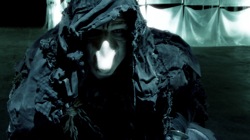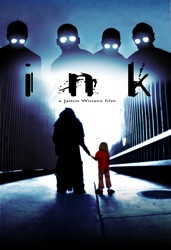The Directors Guild of America building, in all its glossy power, is about a block from where I attended the screening for the independent film, Ink. Living in Los Angeles, the hub of A-List, frillion-dollar budget projects, I sometimes forget the joy of smaller, independent works and I couldn’t help but reflect on this. Why make an independent film? Why work in community theater? Why submit stories to small presses and zines or see local bands in tiny bars? Why? Because art shouldn’t have to wait for a bankroll. Art shouldn’t only be about stars, fame and cash. Whatever secret rock star dreams we may hold, the relevance is in creation and appreciation more than distribution and percentages.
There are no big name actors in Ink. Writer/director Jamin Winans has five films on his IMDB page, but I’d never heard of him before. I don’t know what the budget was, but no doubt it was small by big studio standards. A short making-of feature after the film showed one of the actors helping out sewing his costume. That brief, endearing moment said a lot about what sort of project this was.
Of course, no matter how much smaller-scale art projects might warm my jaded Hollywood-native heart, no amount of sentiment will answer the question that a review is supposed to answer: Was it a good movie? Not to put to fine a point on it: Hell yes.
The marketing material for the film call it Sin City meets It’s a Wonderful Life. OK, sorta. I’d think it more along the lines of a Whedonesque Wings of Desire with a splash of Jeunet and Caro. The film centers on self-centered salaryman John, estranged from his daughter, Emma. The real-world story is about them, anyway, but there is a second story, taking place in a ghostly realm of dreams that lays over the real world. There, on one side of the conflict is a group of muse-like beings who give people good dreams (and dress kinda street and fight like bad-asses) and on the other, nightmarish icky folks who look like Cenobite accountants. Between them is a lost and deranged being, the eponymous Ink, who kidnaps Emma’s soul.
Telling you more about the plot than that would be a mistake. I will say, though, that the initial fight scene between Ink and the good guys is one of the most seriously cool battles in the history of tract housing.
I’ve read that in Hitchcock’s Rear Window, the audience is drawn into the protagonist’s voyeurism because his room is essentially an eye, the window is the pupil and his camera is literally a lens. The set design directed the audience’s focus. In Ink, Winans and his team made excellent use of light and editing as storytelling features. Rough, slap-you-around cuts bring you into John’s anxiety. Time-lapse sweeps through the city—a sped up version of what Wenders did in Wings of Desire to show the angels’ perspective—introduce us to the vantage of the other realm’s beings. Broad, glowing light evenly illuminating an entire scene gives the audience a sense of supernatural observation, telling us of the watchful presence of the muses. (That’s my word for them, anyhow. I don’t think the film named them). Darkness punctured by jagged flashes and faces projected and distorted on glass tells the audience that beyond a doubt the Incubus (that’s what they’re called in the movie) people are straight-up evil.
Whether as purely an aesthetic choice or due to budget constraints or a bit of both, indie films often make great use of lighting, and Ink is a solid example of this. Shadows and light are the original special effects, after all, among the most fundamental tools of theater. I couldn’t help but wonder if the creative emphasis on lighting in Ink would have happened in the hands of some big-ass CGI-happy studio.
Because Ink doesn’t currently have a distributor, screenings have been arranged in various cities. Ink begins a theatrical run in Los Angeles on Friday, September 11 at Laemmele Sunset 5 in West Hollywood. If you live elsewhere, you can sign up for updates at their website.
When Jason Henninger isn’t reading, writing, juggling, cooking or raising evil genii, he works for Living Buddhism magazine in Santa Monica, CA.










